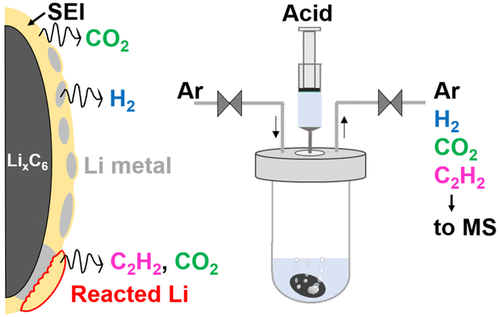当前位置:
X-MOL 学术
›
ACS Energy Lett.
›
论文详情
Our official English website, www.x-mol.net, welcomes your
feedback! (Note: you will need to create a separate account there.)
Quantification of Inactive Lithium and Solid–Electrolyte Interphase Species on Graphite Electrodes after Fast Charging
ACS Energy Letters ( IF 19.3 ) Pub Date : 2020-05-21 , DOI: 10.1021/acsenergylett.0c00859 Eric J. McShane 1, 2 , Andrew M. Colclasure 3 , David E. Brown 1, 2 , Zachary M. Konz 1, 2 , Kandler Smith 3 , Bryan D. McCloskey 1, 2
ACS Energy Letters ( IF 19.3 ) Pub Date : 2020-05-21 , DOI: 10.1021/acsenergylett.0c00859 Eric J. McShane 1, 2 , Andrew M. Colclasure 3 , David E. Brown 1, 2 , Zachary M. Konz 1, 2 , Kandler Smith 3 , Bryan D. McCloskey 1, 2
Affiliation

|
Rapid charging of Li-ion batteries is limited by lithium plating on graphite anodes, whereby Li+ ions are reduced to Li metal on the graphite particle surface instead of inserting between graphitic layers, which directly contributes to cell capacity loss because of the low reversibility of the Li plating/stripping process. Precisely identifying the onset and amount of Li plating is therefore vital in order to remedy these issues. We demonstrate a titration technique with a detection limit of 20 nmol (5 × 10–4 mAh) of Li that can be used to quantify inactive Li that remains on the graphite electrode after fast charging. The titration is extended to quantify the total amount of solid carbonate species and lithium acetylide (Li2C2) within the solid–electrolyte interphase (SEI), and electrochemical modeling is used to determine the Li plating exchange current density (10 A/m2) and stripping efficiency (65%) of plated Li metal on graphite. These techniques provide a highly accurate measure of the onset of Li plating and quantitative insight into graphite SEI evolution during fast charging.
中文翻译:

快速充电后石墨电极上惰性锂和固态电解质间相物种的定量
锂离子电池的快速充电受到石墨阳极上的锂电镀的限制,因此,Li +离子在石墨颗粒表面上被还原为锂金属,而不是插入石墨层之间,这直接导致了电池容量的损失,因为其可逆性低。锂电镀/剥离工艺。因此,准确地确定锂镀层的起始量和数量对于补救这些问题至关重要。我们展示了一种滴定技术,其Li的检出限为20 nmol(5×10 –4 mAh),可用于定量快速充电后残留在石墨电极上的惰性Li。扩展滴定以定量固体碳酸盐物质和乙炔锂(Li 2 C 2)在固-电解质界面(SEI)中,并通过电化学建模来确定锂在石墨上的镀锂交换电流密度(10 A / m 2)和剥离效率(65%)。这些技术为快速充电过程中的锂镀层的开始提供了高度准确的测量方法,并定量了解了石墨SEI的演变。
更新日期:2020-05-21
中文翻译:

快速充电后石墨电极上惰性锂和固态电解质间相物种的定量
锂离子电池的快速充电受到石墨阳极上的锂电镀的限制,因此,Li +离子在石墨颗粒表面上被还原为锂金属,而不是插入石墨层之间,这直接导致了电池容量的损失,因为其可逆性低。锂电镀/剥离工艺。因此,准确地确定锂镀层的起始量和数量对于补救这些问题至关重要。我们展示了一种滴定技术,其Li的检出限为20 nmol(5×10 –4 mAh),可用于定量快速充电后残留在石墨电极上的惰性Li。扩展滴定以定量固体碳酸盐物质和乙炔锂(Li 2 C 2)在固-电解质界面(SEI)中,并通过电化学建模来确定锂在石墨上的镀锂交换电流密度(10 A / m 2)和剥离效率(65%)。这些技术为快速充电过程中的锂镀层的开始提供了高度准确的测量方法,并定量了解了石墨SEI的演变。











































 京公网安备 11010802027423号
京公网安备 11010802027423号